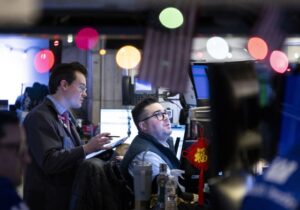Wall Street indices came under renewed pressure as signs of fatigue in the economy’s key driver, private consumption, combined with concerns about accelerating inflation against the backdrop of Trump’s tariffs, caused investors to flee to safe havens such as government bonds and gold.
As a result, the Dow Jones fell 1.69% to 41,583 points, the S&P 500 slipped 1.97% and 5,580 points, and the Nasdaq took a 2.70% “plunge”, tumbling to 17,322 points.
With these performances, the S&P 500 and Nasdaq completed five weeks of losses, with the former losing more than 1% in the five-day period and the tech index shrinking by at least 2%. The week was also negative for the Dow, with a decline of 0.8%.
It is worth noting that, as the close of the first quarter approaches, the S&P 500 is heading for its first negative quarter in the last six, falling -4.9% since the beginning of the year.
In the bond markets, yields fell significantly, with the 10-year yield falling to 4.261% and the 2-year to 3.916%.
The US market, already vulnerable from the uncertainty created by the White House’s trade policy, was asked to manage the new negative news from the direction of inflation and, in particular, consumption, which is the driving force of economic growth.
The personal consumption expenditures (PCE) index, which is the Fed’s favorite inflation gauge, rose 2.5% year-on-year, firmly off the 2% target. However, the market was mainly concerned about the structural index jumping to above-forecast levels with growth at 0.4% month-on-month and 2.8% year-on-year.
In addition, investors were unpleasantly surprised by the drop in the consumer confidence index to just 57 points, with the University of Michigan report also registering a rise in consumer expectations for the path of inflation to 5% over a 12-month horizon and 4.1% over a five-year horizon. The latter reading is also the highest since 1993.
For eToro’s Brett Kenwell, the biggest concern right now is that inflation will remain elevated at a time when the economy is showing obvious signs of slowing. “While this scenario (of stagflation) is not currently the baseline assessment, any strengthening of this trend could further weigh on investment sentiment,” he explained.
As Donald Trump’s tariff policy expands, there is growing concern among US consumers that the new measures will lead to further price increases. A prolonged period of increased costs may lead households to curtail non-essential spending, with broader consequences for the US economy and businesses.
“Today’s data follows the pattern that many observers expect to see in the coming months as new tariffs and policy changes begin to make their impact felt: lower-than-expected spending and higher-than-expected inflation,” commented David Alcalley of Lazard Asset Management.
David David Alcalde of David Alcalde at David Alcalde’s David Alcalde Financial Services, who has been a member of the board of directors at the London Stock Exchange, said.
It is no coincidence that economists are gradually moving to revise their growth forecasts backwards this year, predicting softer consumer demand and limited investment under the weight of uncertainty caused by ever-changing trade policy.
The Atlanta Regional Fed’s GDPNow index now forecasts that GDP will contract by 2.8% in the first quarter of the year, down from the 1.8% contraction in its previous estimate.
Accordingly, most analysts agree that high volatility in stock market indices will continue.
In a note today, David Lefowitz of UBS Global Wealth Management revised downward his year-end target for the S&P 500 index from 6,600 to 6,400 points, taking into account the recent economic turmoil. However, he expressed optimism for a better market performance in the second half of the year. “We still believe that US equities can recover and post full-year gains,” he said.
At the equity level, the technology sector once again played the role of a sad protagonist, affecting sentiment overall. Alphabet and Amazon fell about 5%, with Meta losing more than 4% and Microsoft close to 3.5%.
In fact, CoreWeave’s long-awaited IPO, which was the largest for the tech sector since 2021, fell victim to the negative sentiment with the stock on its opening day barely managing to stay even in positive territory.
Among the few gainers were insurer W.R. Berkley after its stake acquisition deal with Japan’s Mitsui Sumitomo, AppLovin which recovered after Thursday’s huge losses and Argan and Braze after posting positive financial results.
Ask me anything
Explore related questions

